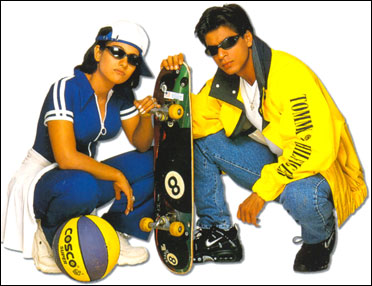| It would be impossible to think of an exceedingly idealistic yet acutely cynical soul like Vijay, the poet of Pyaasa, surviving in the contemporary, consumerist, globalised India. Similarly, a flamboyant yet matter-of-fact and conciliatory Raj of Dilwale Dulhania Le Jaayenge could not have captured the imagination of a socialist, post Independence India. Each stage in the life of a nation gives rise to its own stories, fashions unique narratives and invents distinctive heroes and heroines who embody the values and principles of the times. We pick some who were born and bloomed in the Bollywood of liberalised India.
Raj and Simran in Dilwale Dulhania Le Jaayenge (1995)
SRK and Kajol, as Raj and Simran, redefined love for brand new India. It was no longer about confronting class and caste differences but about persistent reconciliations. Raj and Simran’s conformist attitude reflected the spirit of a country in the throes of economic reforms: grounded, steady, practical than dreamy and idealistic.
Mili in Rangeela (1995)
“Itne chehron mein apne chehre ki pehchaan to ho, bade bade naamon mein apna bhi naam-o-nishaan to ho” sang junior artiste Mili (Urmila Matondkar) as she dreamt of becoming a top star. Much like how the rest of middle class India aimed at striking it big in life. Urmila’s fitness, makeover and hip outfits made many on the streets smarten themselves up too.
 Rahul, Anjali and Tina in Kuch Kuch Hota Hai (1998) Rahul, Anjali and Tina in Kuch Kuch Hota Hai (1998)
Rahul (SRK) wears a chain spelling out ‘COOL’ but also visits a temple every week. Tina (Rani Mukherji) wears minis, strums the guitar but can also sing “Om Jai Jagdeesh Hare” with equal ease. Anjali (Kajol) is a free-spirit who willingly gets tamed into a submissive picture of femininity. Together they personified the trendy-traditional, conservative-modern schisms of post-liberalisation India, its urge to move ahead yet hold on to the past. Together they also made labels like Tommy Hilfiger, DKNY and Gap a must-have in any consumerist yuppie’s expansive wardrobe.
Akash, Sameer and Siddharth in Dil Chahta Hai (2001)
Akash (Aamir Khan), Sameer (Saif Ali Khan) and Sid (Akshaye Khanna) live in fancy houses, wear designer clothes, sport sharp haircuts and travel to Goa and Australia at the drop of their hats. They are unapologetic about their wealth and casual about their lifestyles. In fact they don’t even need to earn their living; their life is all about figuring themselves out as individuals and sorting out their relationships. The urban rich could not have found a more compelling presence in Bollywood than in these liberalised times. Rock On, Lakshya and the recent Wake Up Sid too are a chip of the DCH block.
Babli in Bunty Aur Babli (2005)
Rani Mukherji, as Babli, gets to mouth one of the best lines in contemporary Hindi cinema: “Main ek aur martba aam ka achaar nahin daal sakti”—a precise expression of the boredom, claustrophobia and lack of challenges felt by many a youngster in the sleepy small towns. But, like them, Babli’s aspirations are also fanned by the alternate life she sees on television—the most ubiquitous, potent emblem of liberalisation—and she can go to any extent to fulfil her ambitions, even steal, rob and con.
DJ, Karan, Aslam, Sukhi, Sonia in Rang De Basanti (2006)
DJ (Aamir Khan) is insecure about facing the real world outside the university, Karan (Siddharth) thinks there’s life in migrating abroad, Aslam (Karan Kapur) comes from an orthodox family which opposes his Hindu friends even as he feels suffocated by their ghetto mentality and Sukhi (Sharman Joshi) has only one wish in life, that he shouldn’t die a virgin. Together they spoke to contemporary Indian youngsters, expressed their carelessness, selfishness, materialism, consumerism and lack of idealism. And also showed them an easy way to protest: by lighting candles at India Gate.
Dev, Paro and Chanda in Dev D (2009)
Sarat Chandra’s characters get a new age makeover in Anurag Kashyap’s revisionist take. The love of Paro (Mahie Gill) and Dev (Abhay Deol) becomes lascivious, lusty and shorn of sentimentality. Chanda (Kalki Koechlin) has her life wrecked by the MMS scandal. The love-story is reinvented to show feel-good India’s ugly sub-culture—the hedonism and debauchery, rootlessness and irresponsibility, vodka and coke, cyber sex and MMS porn.
Bittoo and Shruti in Band Baaja Baaraat (2010)
Bittoo (Ranveer Singh) and Shruti (Anushka Sharma) choose an unusual career, that of a wedding planner, have the right amount of pushiness and sense of enterprise to start from the scratch and make it big in life and desire a Mercedes than mere 800. Yet, success and money apart, they also want to “settle down” in a comfortable, arranged marriage. Just the right combination of ambition and conservatism that has defined the country’s youth in last 20 years.
– Excerpted from
Outlook India |

